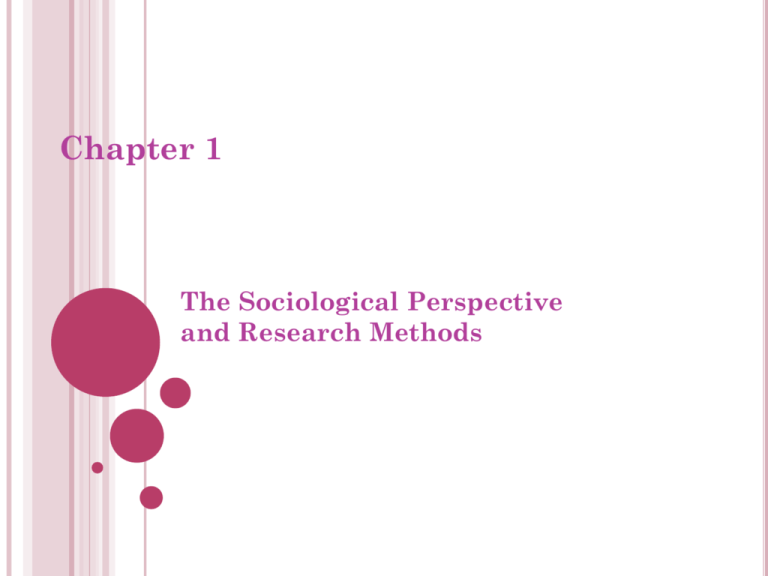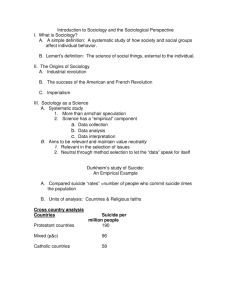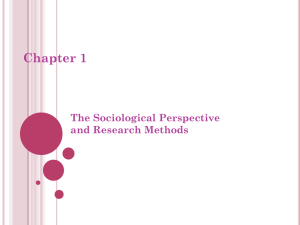Sociology in Our Times: The Essentials
advertisement

Chapter 1 The Sociological Perspective and Research Methods Have you ever wondered… How we can understand suicide as not only an individual act, but an act with structural and social origins? Sociology Students… Explore these questions everyday in an attempt to understand “why people do the things they do” within the structure of a particular society from a sociological perspective. Welcome to an elite group of scholars. The “So What and Who Cares” Factor Sociologists study what has happened, what patterns can be observed and what social factors may have contributed to the existing social condition. The discipline of Sociology also studies who cares and who is affected by the social condition right now. Chapter Outline Contemporary Theoretical Perspectives The Sociological Research Process Research Methods Ethical Issues in Sociological Research Putting Sociological Life into Perspective Sociology is the systematic study of human society and social interaction. Sociologists study societies and social interactions to develop theories about: How behavior is shaped by group life How group life is affected by individuals Why Study Sociology? Helps us gain a better understanding of ourselves and our social world. Helps us see how behavior is shaped by the groups to which we belong and our society. Promotes understanding and tolerance by helping us look beyond personal experiences and gain insight into the larger world order. Fields That Use Social Science Research In many careers, the ability to analyze social science research is an important need. The Sociological Imagination The ability to see the relationship between individual experiences and larger society Helps us place seemingly personal troubles, such as losing a job or feeling like committing suicide, into a larger social context Society A large social grouping that shares the same geographical territory, and is subject to the same political authority and dominant cultural expectations. We are all affected by global interdependence, a relationship in which the lives of all people are intertwined and any nation’s problems are part of a larger global problem. Suicide How can we understand suicide as not just an individualistic act but one with social and structural origins? How Much Do You Know About Suicide? True or False? In the United States, suicide occurs on the average of one every 17 minutes. How Much Do You Know About Suicide? True. A suicide occurs on the average of every 17 minutes in the United States. This differs with respect to the sex, race/ethnicity, and age of the individual. Men are four times more likely to kill themselves than are women. How Much Do You Know About Suicide? True or False? More teenagers and young adults die from suicide than from cancer, heart disease, AIDS, birth defects, stroke, pneumonia, influenza, and chronic lung disease combined. How Much Do You Know About Suicide? True. Suicide is a leading cause of death among teenagers and young adults. It is the third leading cause of death among young people between 15 and 24 years of age, following unintentional injuries and homicide. Suicide As a Personal Trouble: Many people consider suicide to be the result of personal problems. As a Public Issue: Sociologist Emile Durkheim related suicide to the issue of cohesiveness in society instead of viewing it as an isolated act that could be understood by studying individual personalities or inherited tendencies. WHY SUICIDE FOR DURKHEIM Scientific1. According to Durkheim, suicide can occur for personal reasons, but it cannot account for the suicide rate 2. Availability of suicide statistics from Europe (to be seen as rigorous as other sciences) Goal• Action is shaped by society • Sociology must be more than speculation (it must support its claims with evidence e.g. statistics) • Sociological theories must go beneath the surface of phenomena and find hidden underlying causes of behavior Hand out worksheet EMILE DURKHEIM E U R O P E U.S. DURKHEIM’S ARGUMENT Suicide rates are dependent upon the degree to which individuals were integrated into society and the degree to which society regulates individual behavior. Types 1. Altruistic - Excess/integration 2. Anomic - Insufficient regulation 3. Egoistic – insufficient integration 4. Fatalistic – excess regulation EGOISTIC SUICIDE Egoistic Suicide • Individual being insufficiently integrated into the social groups and society • E.g. explains difference in suicide rates of Protestants and Roman Catholics (Catholics more strongly integrated) • Unmarried and childless less integrated, therefore higher suicide rate ANOMIC SUICIDE Anomic Suicide • Took place when society did not regulate individuals sufficiently • Where norms and values are disrupted by rapid social change leading to uncertainty /guidelines for behavior increasingly unclear • Anomic suicide increases during times of economic depression/boom/bust ALTRUISTIC SUICIDE • Individual so well integrated into society that they sacrifice their own life out of a sense of duty to others • E.g. Hindus kill themselves at their husband’s funerals FATALISTIC (PRE-INDUSTRIAL SOCIETY) When society restricts the individual too much - Durkheim thought this type was less important in modern society - But historically interesting, e.g. high suicide rates among slaves. RESPONSE TO THE FOUR TYPES The balance of these 4 types of suicide create a suicide rate • In modern society there are 2 major forms of suicide 1. Increasing detachment from others (leading to egoistical suicide) 2. Dissatisfaction in relation to expectations (leading to anomic suicide) IN CONCLUSION Durkheim accepted that there may be an occasional suicide which could not be placed in any category • Generally suicide has some relationship with social rules or values and the individual • The causes of suicide are not individual • Suicide is structural in origin Suicide Rates by Race and Sex Theoretical Perspectives Theoretical perspectives are based on ideas about how social life is organized. The major perspectives in U.S. sociology are: Functionalist Conflict Symbolic Interactionist Postmodernist Major Theoretical Perspectives Polling Question Which sociological perspective do you think explains the concept of inequality in our society the most accurately? A. B. C. D. Structural-functionalist Conflict Symbolic interactionist Feminist Importance of a Global Sociological Imagination The future of our nation is intertwined with the future of other nations on economic, political, environmental, and humanitarian levels. Understanding diversity and developing tolerance for people who are different from us is important for our personal, social, and economic well-being. The World’s Economies in the Early Twenty-First Century High-Income Countries These are nations with highly industrialized economies; technologically advanced industrial, administrative, and service occupations; and high levels of national and personal income. Examples: United States, Canada They generally have a have a high standard of living and a lower death rate due to advances in nutrition and medical technology. Middle-Income Countries Sometimes referred to as developing countries, these are nations with industrializing economies, particularly in urban areas, and moderate levels of national and personal income. Examples: Nations of Eastern Europe and many Latin American countries, where nations such as Brazil and Mexico are industrializing rapidly. Low-Income Countries Low-income countries are primarily agrarian nations with little industrialization and low levels of national and personal income. Examples: Many of the nations of Africa and Asia, particularly India and even still some parts of China fall into this. Industrialization The process by which societies are transformed from dependence on agriculture and handmade products to dependence on manufacturing industries. First occurred during the Industrial Revolution in Britain between 1760 and 1850. Resulted in massive economic, technological, and social changes. People were forced to leave rural communities to seek employment in the emerging cities. Urbanization The process by which an increasing proportion of a population lives in cities rather than rural areas. The factory system led to a rapid increase in the number of cities and the size of populations. People from diverse backgrounds began working in the same factory and living in the same neighborhoods. This led to the development of new social problems: inadequate housing, crowding, unsanitary conditions, poverty, pollution, and crime. August Comte Considered the “founder of sociology.” Comte’s philosophy became known as positivism— a belief that the world can best be understood through scientific inquiry. Comte believed objective, bias-free knowledge was attainable only through the use of science rather than religion. Two Dimensions of Comte’s Positivism 1. Methodological 2. The application of scientific knowledge to physical and social phenomena. Social and political The use of such knowledge to predict the likely results of different policies so the best one could be chosen. Harriet Martineau Believed society would improve when: women and men were treated equally enlightened reform occurred cooperation existed among all social classes Translated Comte’s works for English speakers. Love Laissez Faire Capitalism Herbert Spencer Contributed an evolutionary perspective on social order and social change. Social Darwinism The belief that the human beings best adapted to their environment survive and prosper, whereas those poorly adapted die out. HERBERT SPENCER CONTINUED He developed a theory of two types of society, the militant and the industrial, which corresponded to this evolutionary progression. Militant society, structured around relationships of hierarchy and obedience, was simple and undifferentiated Industrial society, based on voluntary, contractually assumed social obligations, was complex and differentiated. Emile Durkheim Believed the limits of human potential are socially based. One of his most important contributions was the concept of social facts. Social facts are patterned ways of acting, thinking, and feeling that exist outside any one individual but exert social control over each person. Karl Marx Viewed history as a clash between conflicting ideas and forces. Believed class conflict produced social change and a better society. Combined ideas from philosophy, history, and social science into a new theory. Max Weber Believed sociological research should exclude personal values and economic interests. Provided insights on rationalization, bureaucracy and religion. Georg Simmel Theorized about society as a web of patterned interactions among people. Analyzed how social interactions vary depending on the size of the social group. Developed formal sociology, an approach that focuses attention on the universal recurring social forms that underlie the varying content of social interaction. Jane Addams Founded Hull House, one of the most famous settlement houses, in Chicago. One of the authors of a methodology text used by sociologists for the next forty years. Awarded Nobel Prize for assistance to the underprivileged. W.E.B. Du Bois One of the first to note the identity conflict of being both Black and American. Pointed out that people in the U.S. espouse values of democracy, freedom, and equality while they accept racism and group discrimination. Mr. B wrote a 48 page paper on him. The Sociological Research Process Research is the process of systematically collecting information for the purpose of testing an existing theory or generating a new one. The relationship between theory and research has been described as a continuous cycle. Theory and Research Cycle Quantitative and Qualitative Research Quantitative research focuses on data that can be measured numerically. Example: comparing rates of suicide Qualitative research focuses on interpretive description rather than statistics to analyze underlying meanings and patterns of social relationships. Example: analyzing contents of suicide notes to look for recurring themes Conventional Research Model 1. 2. 3. 4. 5. 6. Select and define the research problem. Review previous research. Formulate the hypothesis. Develop the research design. Collect and analyze the data. Draw conclusions and report the findings. Steps in Sociological Research Hypothesized Relationships Between Variables: Causal Hypothesized Relationships Between Variables: Inverse Causal Hypothesized Relationships Between Variables: Multiple Causes Qualitative Research Model 1. 2. 3. 4. Problem formulation: to clarify the research question and to formulate questions of concern and interest Reviewing literature and developing research design occur simultaneously Collecting data in natural settings and analysis of data occurs concurrently, using language of persons studied Draws conclusions and reports findings to others Research Methods: Survey Research Poll in which researcher gathers facts or attempts to determine the relationships among facts Example: U.S. Census Types: Questionnaires, printed research instrument that is self-administered Interviews, and interviewer asks the respondent questions and records answers Allows for multivariate analysis Research Methods: Analysis of Existing Data Materials studied may include: public records, official reports, and raw data collected by other researchers books, diaries, poems, and graffiti movies, television shows, advertisements, greeting cards music, art, and even garbage Content analysis the systematic examination of cultural artifacts or various forms of communication to extract thematic data and draw conclusions about social life Research Methods: Field Research Study of social life in its natural setting. Participant observation Collecting observations while part of the activities of the group being studied. Ethnography Detailed study of the life and activities of a group of people over a period of years. Research Methods: Experiments Carefully designed situation in which researcher studies the impact of certain variables of subject’s attitudes or behavior Experimental group The subjects who are exposed to the independent variable to study its effect on them Control group Subjects who are not exposed to the independent variable ASA Code of Ethics 1. Disclose research findings in full and include all possible interpretations of the data. 2. Safeguard the participants’ right to privacy and dignity, while protecting them from harm. 3. Protect confidential information provided by participants. 4. Acknowledge research collaboration and disclose all financial support. Quick Quiz 1. Sociology helps us get a better understanding of ourselves and our world by: A. B. C. D. enabling us to see how behavior is shaped by the groups to which we belong and the society in which we live. enabling us to see how behavior is shaped by the large social structures that comprise society. enabling us to see how behavior is shaped by the social institutions and close knit friendships in which we belong. enabling us to see how behavior is shaped by a combination of pathological and social forces. Answer: A Sociology helps us get a better understanding of ourselves and our world by enabling us to see how behavior is shaped by the groups to which we belong and the society in which we live. 2. Using the Sociological Imagination allows us to: A. B. C. D. bridge knowledge between Psychology and Sociology. make personal troubles public issues. make in-roads into finding absolute truth. bridge the gap between micro and macro processes. Answer: B Using the Sociological Imagination allows us to make personal troubles public issues. 3. The approach that begins with a theory and uses research to test the theory is called: A. B. C. D. qualitative deductive quantitative inductive Answer: B The approach that begins with a theory and uses research to test the theory is called deductive. 4. Durkheim identified four types of suicide. They are: A. B. C. D. Altruistic, Egoistic, Anomic, Fatalistic Altruistic, Egocentric, Anomic, Fatalistic Altruistic, Anthroscopic, Egocentric, Fatalistic Altruistic, Egoistic, Anthroscopic, Egocentric Answer: A Durkheim identified four types of suicide. They are: Altruistic, Egoistic, Anomic, Fatalistic.








